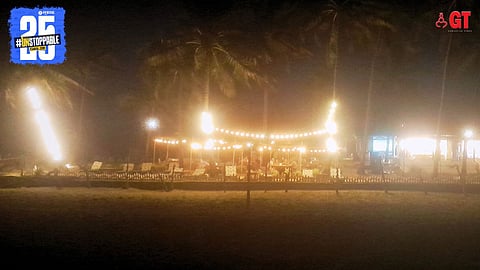Russians enjoy a ‘moonlight sonata’ on the beaches of Goa
The summer heat is changing tourism patterns and showing a clear geographical dividing line between the north and the south.
Foreign tourists, Russians in particular, in the north are spending the evening on the beach, partying all night and returning to their rooms to spend the day, while domestic tourists in the South remain on the beach till sunset.
“It is too hot during the day, and that is why we come out in the evening, and after spending some hours on the beach, meet up with friends to spend the night together,” shares Alexandre who shops along with his friend.
“We have air-conditioning in our room, so getting sleep is no problem. The problem, these days, starts when we come out. It is too hot in the morning, but gets better by late evening,” says Raihna.
“These are days to have beer in the morning, and perhaps a few shots of vodka at night. It is difficult to eat, and hence, we opt for less meats and more vegetables. We pick up fish from the market,” she discloses.
As summer sets in, spots along the northern coast pick up pace at night, with Arambol still the meeting place of choice after sunset.
“Music is not too heavy because it is difficult to dance trance in this heat. The body will explode!” warns Riyaz.
Sufi music, jazz and a bit of pop make for good listening at this time of the year in Arambol, and at many places there is no entry fee. Night meets normally conclude by early morning as most wish to rush to the comfort of their air-conditioned rooms.
If the north is the place for Russians, the south is getting to be the home of domestic tourists, and locals who have started coming to the beach more regularly to take a dip in the sea.
With schools closing for the summer break, families from different parts of India have descended onto South Goa, and can be seen walking on the beach or taking a dip, which is the new style mantra on the beach.
Most beaches in the South are crowded at sunset, and as night sets in, most tourists retreat to their homes, homestays or hotels with a few opting to try meals at shacks that dot the coastline.
The footfalls are neither high nor low, but after 8 pm, a dullness envelopes stretches of the coast.
“The number of customers has decreased, but it is too early to say that it is time to close down. Many close by April, but I am not sure the trend will continue this year,” says shack owner, Dominic.
With schools closing for the summer break, families from different parts of India have descended onto South Goa, and can be seen walking on the beach or taking a dip, which is the new style mantra on the beach.
The North-South divide is turning into a foreigner-Indian zoning along the coastal belt as the sun begins to hum its summer tune. The flow of tourists will continue, though it will not be clearly indicative.
But, the birds will be able to hum to keep stakeholders prepared for the rapid flow of the next season.

